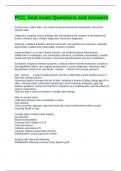PCC, final exam Questions and Answers
Assessment: collect data, use evidence-based assessment techniques, document
relevant data
Diagnosis: compare clinical findings with normal/abnormal variation & developmental
events, interpret data, validate diagnoses, document diagnoses
Planning: establish priorities, develop outcomes, set timelines for outcomes, culturally
appropriate, realistic and measurable, include a timeline
Implementation: in a safe & timely manner, use evidence-based interventions,
collaborate w/ colleagues, use community resources, coordinate care delivery, provide
health teaching & health promotion, document implementation and any modification
Evaluation: progress towards outcomes, conduct criterion-based evaluation, include pt.
and significant others, use ongoing assessment to revise diagnoses, outcomes, plan,
disseminate results to pt. and family - answer What is the nursing process?
falls - answer a major health problem esp 65 or older falls are the leading cause of
fatal and nonfatal injuries
Numerous factors increase the risk of falls, including a history of falling, being age 65 or
older, reduced vision, orthostatic hypotension, lower-extremity weakness, gait and
balance problems, urinary incontinence, improper use of walking aids, and the effects of
various medications.
Falls are also a common problem in health care settings
Minor to severe injury
Underlying disease more susceptible to injury
Interventions
Close proximity, signage, improved hand-offs, nurse toilet/comfort safety rounds,
involving family in care
Foreign object retained after surgery
Air embolism
Blood incompatibility
Pressure Ulcer Stage III or IV
Falls and trauma
Catheter associated UTI
Vascular catheter-associated infection
Manifestations of poor glycemic control
Surgical site infections following:
Mediastinitis following coronary artery bypass graft
,Orthopedic procedures of spine, neck, shoulder, elbow
Bariatric surgery for obesity (laparoscopic gastric bypass, gasteroenterastomy,
laparoscopic gastric restrictive sleeve)
Cardiac implantable medical device
DVT, PE following knee or hip replacement
Iatrogenic pneumothorax with venous catheterization - answer What are the "never
ever" events?
Adequate lighting- orient to surroundings
Remove obstacles from halls and traffic areas
Throw rugs
Necessary patient items on bedside table within reach
Nonessential items away to decrease clutter
No scatter rugs at home or be sure secure with non-skid back
Electronic safety alert device if at risk at home and alone
Yellow wristbands traditionally mean fall risk
Adequate footwear, armbands, surroundings, call light, side rails - answer fall
interventions
Must be clinically justified
Have to have one of the uses for restraints, have to have tried alternatives
MD order required- based on face-t0-face assessment
Order must be current
Must specify duration and circumstances restraint is used
State a specific time frame as per facility policy
8 hours adults
2 hours 9-17
1 hour under 9
On-going assessment
Bc of complications, must assess for them and release restraints, take off and get
person up, see if they still need them
Document
Behaviors of need
Procedure used in restraining
Condition of body restrained
Evaluation of patient response
Removed Periodically and determine need to continue
May not be ordered PRN
Consent if necessary - answer restraint orders
alarms: Weight and motion sensor mats on beds and chairs
Can be silent or audible alarms with pressure changes
Door alarms, Help with confused patients; *alarms are considered restraints In long
term care facilities*
side rails: Increase patient mobility and stability
, Most commonly used physical restraint
Can cause falls or death
Not typically used in long term care facilities for this reason
4 up in hospital = restraint
2 is good, 3 is ok for fall risk
If 3rd is on side where patient has problem w/ mobility, 3 would be considered restraint -
answer restraint interventions
restraints - answer Physical
Any manual method or physical or mechanical device, material, or equipment that
immobilizes or reduces the ability of the patient to move arms, legs, body, or head.
Chemical
Medications used to manage a patients behavior and are not standard treatment or
dosage for the patients condition.
"as needed" medications, try to do other things before giving meds
Use of restraints involves psychological adjustment for the family
Legally must know agency policy and procedures regarding restraints and monitoring
Used in hospitals, not long term care facilities
Pressure Ulcers-friction
Pneumonia-immobility
Constipation-immobility
Incontinence
Death
Psychological- loss of self-esteem, humiliation, agitation, isolation - answer
complications of restraints
Explain procedures and environment
Companionship
Family member, PCA, hospital sitter
Diversionary activities
Getting someone active
Close to nurses station if confused
Calm, simple instructions
De-escalation techniques
Relaxation techniques
Exercise and ambulation
Basic needs- toileting, food, drink
Seem to work the most
Hide lines
Evaluate medication for possible side effects
Reassess labs
** must try several before physically/chemically restraining someone** - answer
restraint alternatives




